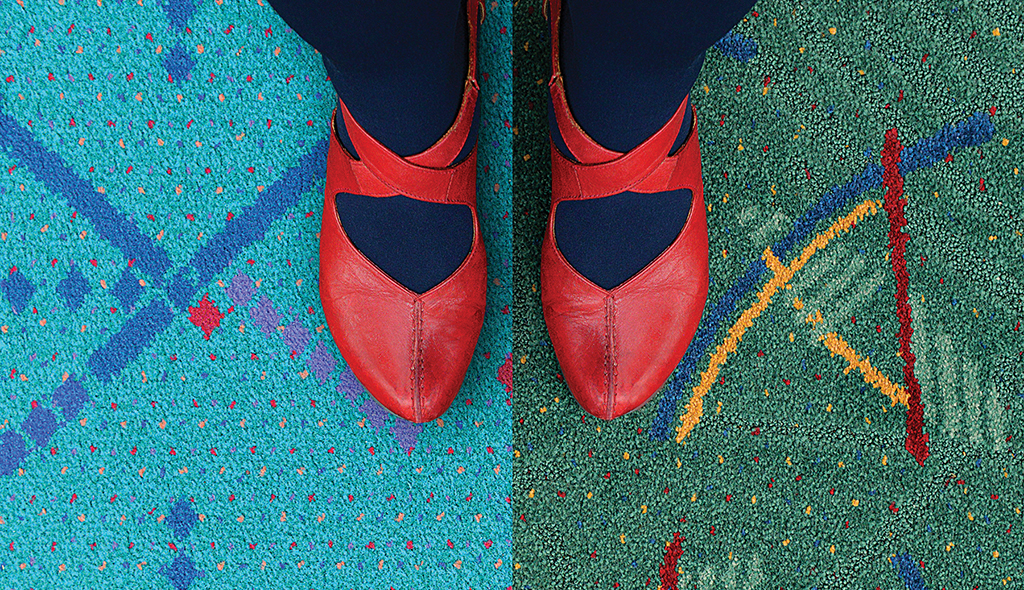Recycler of the Year - “Carpet” Diem Award: Port of Portland
 In the 20+ years since its installation, the Portland community connected with the Portland International Airport (PDX) carpet and viewed it as a symbol of Portland. In 2015, the Port of Portland began a project to remove and replace 13 acres of carpet throughout the airport. Given the commitment to organizational sustainability, the Port emphasized the need for sustainable disposal of the carpet in the request for proposal (RFP).
In the 20+ years since its installation, the Portland community connected with the Portland International Airport (PDX) carpet and viewed it as a symbol of Portland. In 2015, the Port of Portland began a project to remove and replace 13 acres of carpet throughout the airport. Given the commitment to organizational sustainability, the Port emphasized the need for sustainable disposal of the carpet in the request for proposal (RFP).
Once news of the carpet replacement was released, public interest in the PDX carpet replacement project flourished. PDX carpet fever quickly spread through the city of Portland, and to the 15 million passengers traveling through PDX each year. Gaining the attention of local and national news and media, the old carpet was even the official mascot of the 2015 Rose Festival Parade.
Rubenstein’s, a Pacific NW–based, 40 year-old commercial floor covering company, was contracted to lead the carpet replacement project. The initial research highlighted the difficulties of recycling carpet. The type and condition of the carpet, along with limited processing facilities in the Northwest, narrowed disposal options to landfilling or incineration at a waste to energy facility. Given the tremendous public affinity for the iconic airport carpet, Rubenstein’s looked for, and found, a more sustainable disposal option for the high-profile carpet.
As the carpet fad and public interest grew, it presented a unique opportunity with local demand for pieces of the iconic carpet. The Port leveraged that interest and decided to make available portions of the carpet to the community. This further extended the useful life and nostalgia of the carpet, while diverting it from the landfill or waste to energy facility.
While giving the iconic PDX carpet away to interested individuals and organizations was a fantastic opportunity for reuse, this option came with its own set of challenges. To ensure equity and fairness, the Port asked for proposals from businesses interested in obtaining some of the old carpet. The Port evaluated proposals based on what interested businesses proposed to do with it, how their work would benefit the local community, and to ensure the carpet wouldn’t end up in the landfill.
This evaluation process took time and energy on the part of the applicants, the Port, and Rubenstein’s. Under normal circumstances, carpet is typically removed as quickly as possible with no regard for the condition. Because this carpet was being repurposed, Rubenstein’s had to develop a strategy and technique to remove the carpet in larger, intact pieces. Some areas of carpet was more worn than others and these sections had to be evaluated then all the carpet had to be organized and stored for distribution.
In total, more than 20,000 square yards of carpet was reused by selected community partners. The carpet was reinstalled and used as floor covering for buildings throughout the region, used in batting cages at a local high school, repurposed into a variety of novelty products, and used as furniture upholstery.
While the Port distributed 34% of the carpet to the community, eight acres of carpet remained for disposal. Rubenstein’s felt sought a more sustainable disposal option for the remaining carpet than landfilling or incineration. They found that more sustainable disposal option through the Los Angeles Fiber Company located in Vernon, California that reuses carpet fibers to make carpet pad. By sending the remaining PDX carpet to this facility, the Port and Rubenstein’s extended the life of carpet and kept 100% of the replaced carpet from the landfill or incineration. This option has multiple benefits including preventing the use of additional resources such as plastic and fibers, limiting GHG emissions, and extending the useful life of carpet materials.
The project RFP primarily sought a more sustainable disposal option for the carpet. Rubenstein’s embraced the Port’s commitment to reducing waste and was able to further divert waste materials throughout the project. Cardboard cores from the rolls of new carpet were given to a local carpet warehouse to reuse, pallets were returned to suppliers, wood from broken pallets was used to make furniture and art pieces, and all plastic film was recycled.
Thirteen acres of carpet, almost 200 tons, was removed and replaced. And 100% of the removed carpet was reused or recycled!


